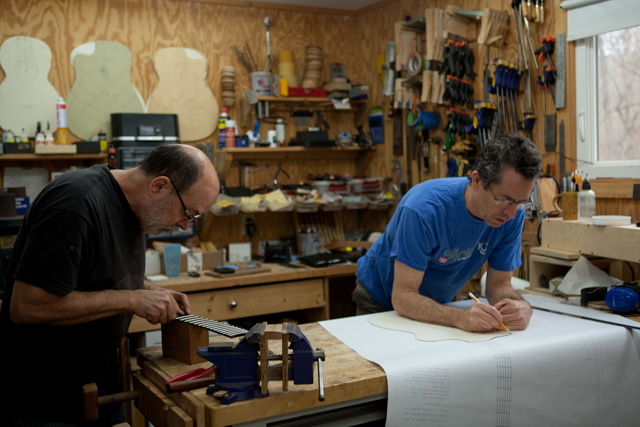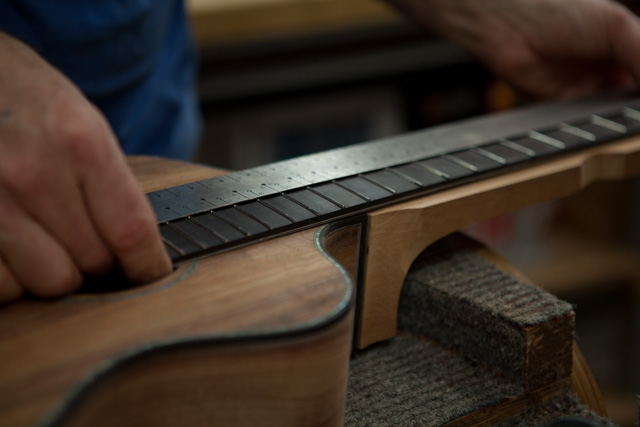I take a deep breath, plunge the router bit into the wood, flip the lever to hold it at the proper depth, and carefully and slowly rout the string slots into the headstock. Jay Lichty is holding the guitar’s neck steady, though it’s clamped tightly into a vice. I proceed to pass the router several times around the slotting jig and when Jay and I both see that I’ve cut the slot cleanly, I turn off the router, Jay lets go of the neck as we both breathe a sigh of relief, and unconsciously and out of fear that the router will jump its jig and skitter across the guitar’s headstock, I’ve been pushing down mightily on the router. So mightily that when Jay releases the neck, I push it down, the router does jump the jig, and I put deep gouges in both sides of the slot I’ve cut. I didn’t know my own strength and Jay had no reason to believe that I’d be using any effort to push down the router. “Oh,” he says calmly, “you don’t need to push down on it. The router’s weight is sufficient to keep it in place.”
We’re nearing the end of an incredibly fun and productive fourth day of guitar building. Jay and I now work like a single machine, but only half of which is well oiled. My squeaky, clunky side of the machine is always eager to embrace the task, no matter how challenging. As a result, I have great pride in accomplishment. Moreover to the extent that we learn by our mistakes, I must already number among the world’s most knowledgeable luthiers, though certainly not among the world’s most talented.
This is the second of my errors today. Earlier, in my zest for scraping the bindings, I chipped out a couple of chunks of the delicate, eighth inch wide, abalone purfling. As with my later error, Jay functions as witness, therapist, mentor, and savior. We calmly assess the damage, Jay solicits my opinion about corrective action, considers it, offers his insight, and we agree on a plan of action.
Correcting both errors demands steadier and more talented hands than I possess. So, with the purfling damage, Jay carefully routs out the small sections that I’ve destroyed and we glue in replacement pieces. With the headstock string slot catastrophe, we need to widen each side of the slot by a sixteenth of an inch. I get back on the routing horse and rout, without incident, to the originally designed dimensions on the second slot and Jay takes over when we need to move the jig a sixteenth to each side of the original targets. It’s then my job to hand sand the slots until they look like we designed them that way.
These two events serve as a microcosm of what makes a Jay Lichty workshop so worthwhile. He lets me work at my rate and have input into design and execution. He’s also a superb teacher who instructs not only in wise words, but in allowing the student to participate in the problem solving that lutherie entails. Especially, of course, with student luthiers. The result is exhilarating, instructive, and both physically and mentally challenging and rewarding. This is not merely a lesson in guitar making, though it surely is that. It’s also a lesson in creativity, flexibility, and developing an approach to problem solving that, because it embraces the non-obvious, necessitates multi-layered reasoning.
So, the journey is beyond rewarding. But, to the extent that I can see it, the destination – the beautiful all-koa parlor guitar that I am crafting – is also more than gratifying.
Jay later tells me that each workshop guitar takes on the personality of its student builder. “Yours will have more than its share of moxy and when you make a mistake, the guitar will instantly begin calculating how to work that into a new composition.” “Yeah,” I respond, “and it will always be about three notes ahead of me.” Jay nods, while displaying a wry, knowing smile.
As tiring as another ten hours of work have made me, my overwhelming sentiment as I write this is of excitement for what tomorrow brings, both in process and progress.
All photos by Corrie Woods.
……….


Bound box pre sanding

Contemplating on how to repair my latest mistake

I install fingerboard side dots while Jay works on neck geometry

Jay demonstrates fret cutting

Jay dreams up his next design while I complete the fretting

Jay locates fingerboard placement.

Jay rerouts the purfling where I over scraped

Jay sets up another guitar while I install frets

Knocking off the high spots on the binding and purfling

Measuring for side dot placement

Preparing the fingerboard

Scarping that binding just before my first big error

Tapping in the frets

With neck and fingerboard roughed out.

Bound and sanded

Bound box in shop pre sanding


